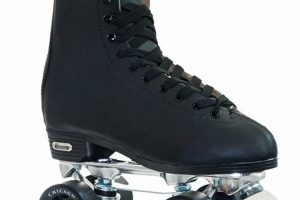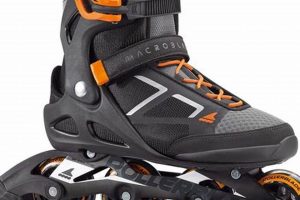Attire associated with skateboarding culture includes functional and expressive clothing choices. This style often incorporates durable fabrics, loose fits for ease of movement, and graphic elements reflecting skateboarding aesthetics. Examples include comfortable pants, t-shirts featuring logos or artwork, hoodies, and specific types of footwear designed for board control.
This particular style offers practical advantages for the activity it represents, providing comfort and protection during skateboarding. Historically, it has evolved from purely functional needs to a recognized subcultural expression, influencing broader fashion trends and representing a lifestyle choice beyond the sport itself.
The following sections will examine specific elements of this style, from footwear to accessories, exploring how these components contribute to the overall aesthetic and functionality. The exploration will also encompass the cultural significance and evolving trends within this defined fashion sector.
Selecting appropriate attire requires careful consideration of both practicality and aesthetic preferences. The following guidelines provide a framework for constructing a wardrobe reflective of this style.
Tip 1: Prioritize Functionality: Loose-fitting garments permit a greater range of motion. Opt for durable materials like canvas or denim to withstand wear and tear associated with skateboarding.
Tip 2: Embrace Comfortable Footwear: Shoes designed for skateboarding offer enhanced grip and board feel. Look for reinforced stitching and durable soles to maximize longevity.
Tip 3: Incorporate Graphic Elements: T-shirts and hoodies featuring band logos, skate brand designs, or original artwork contribute to the visual identity. Consider the message conveyed by chosen graphics.
Tip 4: Layer Strategically: Hoodies and jackets provide warmth and protection. Choose versatile pieces that can be easily added or removed depending on weather conditions.
Tip 5: Accessorize Purposefully: Beanies, baseball caps, and belts serve both functional and stylistic roles. Select accessories that complement the overall look and provide practical benefits such as sun protection.
Tip 6: Focus on Authenticity: Avoid blatant imitation. Draw inspiration from skateboarding culture, but develop a personal style that reflects individual preferences and values.
Tip 7: Value Quality Over Quantity: Invest in well-constructed garments that will endure regular use. A smaller selection of durable pieces is preferable to a larger collection of inferior items.
Adhering to these principles will facilitate the creation of a functional and aesthetically pleasing wardrobe that aligns with the core tenets of skateboarding-influenced menswear.
The subsequent sections will delve deeper into specific garment types and provide additional insights into maintaining a consistently relevant and practical style.
1. Durability
Durability is a paramount consideration within skateboarding attire, directly influencing the longevity and functionality of garments. The sport’s inherently abrasive nature necessitates materials and construction techniques capable of withstanding considerable wear and tear. The selection of durable components is not merely aesthetic; it is integral to the practical application and lifespan of the attire.
- Material Selection
The choice of fabrics significantly impacts the garment’s resistance to abrasion. Denim, canvas, and reinforced synthetics are commonly employed due to their inherent strength and ability to withstand repeated friction against concrete and other surfaces. For example, a skateboarder’s pants made of heavy-duty canvas will resist tearing much longer than a pair made of a lighter, less robust material. The implication is reduced replacement frequency and sustained performance during skateboarding activities.
- Reinforced Construction
Strategic reinforcement of stress points enhances the overall durability of the garment. Double or triple stitching at seams, reinforced pockets, and the inclusion of extra layers of fabric in high-wear areas contribute to increased resistance to tearing and abrasion. Consider the reinforced knees often found in skateboarding pants; this feature extends the life of the garment by protecting against the impact and friction inherent in certain skateboarding maneuvers.
- Hardware Integrity
Zippers, buttons, and other hardware components must also exhibit durability to ensure the garment’s functionality. High-quality metal zippers and sturdy buttons are preferred over their plastic counterparts due to their increased resistance to breakage and wear. A broken zipper on a jacket, for instance, renders the garment less useful, highlighting the importance of durable hardware in the context of skateboarding.
- Sole Construction (Footwear)
The soles of skateboarding shoes are subjected to intense pressure and abrasion. Durable rubber compounds and vulcanized construction techniques are employed to maximize grip, board feel, and longevity. The sole must withstand constant contact with the skateboard’s grip tape. A durable sole, like one made with vulcanized rubber, ensures the shoe remains functional and provides adequate board feel for an extended period.
The emphasis on durability is inextricably linked to the practicality and longevity of skateboarding attire. The selection of robust materials, reinforced construction methods, and high-quality hardware contributes directly to the garment’s ability to withstand the rigors of skateboarding. This focus on durability ultimately translates to a more sustainable and cost-effective wardrobe for individuals involved in the sport, ensuring garments remain functional and reliable for extended periods.
2. Comfort
Comfort is a foundational element of skater fashion, arising from the practical demands of the sport. The unrestricted movement necessary for skateboarding necessitates attire that does not inhibit flexibility or cause discomfort during extended periods of activity. Tight or restrictive clothing can impede performance and increase the risk of injury; therefore, loose-fitting garments are a standard feature. For example, oversized t-shirts and baggy pants permit a full range of motion during tricks, while a lack of restrictive seams or stiff fabrics prevents chafing and irritation. This attention to comfort directly enhances the skater’s ability to perform maneuvers and practice for longer durations.
The influence of comfort extends beyond mere physical ease. The psychological comfort provided by familiar and unrestrictive clothing can also contribute to a skater’s confidence and focus. Clothing that feels natural and non-distracting allows the individual to concentrate on the task at hand, rather than being preoccupied with discomfort or limitations imposed by their attire. Furthermore, the prevalence of soft, breathable fabrics such as cotton or blends minimizes perspiration buildup and regulates body temperature, further enhancing the wearer’s overall comfort level. As an example, consider the prevalence of hoodies in skater fashion; these garments offer warmth and protection, but are also inherently comfortable and non-restrictive, contributing to a sense of ease and confidence.
Understanding the importance of comfort within skater fashion provides a practical framework for selecting appropriate attire. Prioritizing loose fits, breathable materials, and non-restrictive designs allows skaters to optimize their performance and overall experience. While aesthetic considerations remain relevant, the fundamental need for comfort should not be overlooked, as it directly impacts the individual’s ability to engage effectively with the sport. Challenges may arise in balancing comfort with stylistic preferences, but the core principle remains that clothing should facilitate, rather than hinder, the physical demands of skateboarding. In essence, skater fashion demonstrates a pragmatic integration of style and functionality, with comfort serving as the crucial nexus between the two.
3. Functionality
Functionality constitutes a core tenet of skater fashion, dictating the design and construction of garments to meet the specific demands of skateboarding. This focus on practical utility transcends mere aesthetic considerations, influencing material selection, garment construction, and overall design philosophy.
- Range of Motion
Skateboarding necessitates a full range of motion. Garments, therefore, must not restrict movement. Loose-fitting designs, such as baggy pants and oversized t-shirts, allow for unrestricted flexibility during tricks and maneuvers. Restrictive clothing hinders performance and can increase the risk of injury. Consequently, garments must facilitate, not impede, the physical demands of the sport.
- Impact Resistance
Falls are an inherent aspect of skateboarding. While not always explicitly incorporated, certain elements of skater fashion provide a degree of impact resistance. Thick fabrics, such as denim or canvas, offer minimal protection against abrasions. Padded jackets or reinforced knees on pants can further mitigate the impact of falls. The incorporation of protective elements, while often subtle, contributes to the overall functionality of the attire.
- Board Feel and Grip (Footwear)
Skateboarding shoes are designed with specific features to enhance board feel and grip. Flat, vulcanized soles provide optimal contact with the skateboard, allowing for precise control. Durable materials withstand the abrasive nature of grip tape. Reinforced stitching and padded collars offer support and protection. These features are not merely stylistic; they directly contribute to the skater’s ability to execute maneuvers effectively.
- Pocket Placement and Utility
Practicality extends to the placement and design of pockets. Secure pockets, often with closures such as zippers or buttons, prevent items from falling out during activity. Strategically placed pockets provide easy access to essential items, such as tools or mobile devices. The utility of pocket design contributes to the overall functionality of the attire, facilitating the skater’s ability to carry necessary items without compromising performance.
The multifaceted nature of functionality within skater fashion underscores the practical considerations that inform garment design. From facilitating range of motion to enhancing board feel and providing impact resistance, each element contributes to the overall utility of the attire. This emphasis on functionality distinguishes skater fashion from purely aesthetic trends, highlighting the symbiotic relationship between style and performance.
4. Authenticity
Authenticity within skater fashion represents a complex interplay between genuine adherence to skateboarding culture and individual expression. The origin of this style lies in the practical needs of skateboarders, leading to a focus on durable, comfortable clothing that allows for unrestricted movement. This functional foundation provides the basis for authenticity, demanding that garments reflect the sport’s practical requirements. For instance, the prevalence of specific shoe brands associated with skateboarding stems from their proven performance and durability, establishing them as authentic choices within the subculture. Wearing such shoes is therefore not merely a stylistic decision, but a recognition of their inherent functional value within the skateboarding context.
Furthermore, authenticity encompasses a rejection of overt commercialization or artificial adoption of skater aesthetics. True adherence to the style involves an understanding of its history and a genuine engagement with skateboarding culture, rather than a superficial imitation of its visual elements. Consider the appropriation of skate brands by mainstream fashion; while such trends may borrow stylistic cues, they often lack the practical understanding and cultural context that define authentic skater fashion. This distinction is crucial, as authenticity implies a lived experience within the skateboarding community, reflected in the individual’s clothing choices.
The importance of authenticity lies in its ability to differentiate genuine participants from those who simply emulate the style. Understanding this principle ensures that the selected attire is not merely a costume but a reflection of a deeper connection to skateboarding. Challenges arise in navigating evolving trends and commercial influences while maintaining a commitment to the core values of practicality and cultural understanding. Ultimately, authenticity within skater fashion signifies a conscious choice to prioritize function, history, and genuine engagement over superficial trends, representing a commitment to the spirit of skateboarding itself.
5. Individuality
Individuality serves as a critical component within the framework of skater fashion. While certain stylistic elements are commonly associated with skateboarding culture, the expression of personal identity remains paramount. This is not merely an adherence to prescribed trends but a conscious curation of attire that reflects the individual’s personality, preferences, and relationship with skateboarding itself. The rejection of uniformity underscores this aspect, allowing for the incorporation of vintage pieces, DIY modifications, and unique combinations of garments that differentiate one skater’s style from another. For example, one individual might combine classic skate shoes with hand-painted jeans and a vintage band t-shirt, creating a unique ensemble that reflects their personal taste and connection to both music and skateboarding. This personalization elevates the clothing beyond mere functional wear, transforming it into a canvas for self-expression.
The importance of individuality extends beyond simple aesthetic considerations. It fosters a sense of community based on shared passion rather than uniform appearance. Skaters often express their identities through customizing their boards, adding personal touches to their clothing, or supporting independent brands that align with their values. This active participation in shaping the aesthetic landscape contributes to the subculture’s dynamism and prevents it from becoming stagnant or overly commercialized. A practical application of this understanding lies in encouraging new skaters to experiment with their style, fostering self-confidence and a sense of belonging within the community. By valuing personal expression, the skateboarding subculture reinforces its commitment to inclusivity and authenticity.
In summary, individuality is not merely a stylistic option within skater fashion; it is a fundamental principle that shapes the culture and strengthens community bonds. While adherence to certain functional norms remains important, the freedom to express personal identity through clothing allows for a diverse and dynamic range of styles. Challenges may arise in balancing individual expression with the desire to fit in, but the overarching emphasis on authenticity and self-expression ensures that individuality remains a defining characteristic of skater fashion. This understanding is essential for appreciating the nuanced relationship between personal identity and subcultural affiliation within the skateboarding world.
6. Protection
Protection, as a functional element, directly influences the selection and design of attire within the context of skateboarding. The inherent risks associated with the sport, including falls and abrasions, necessitate clothing that offers a degree of physical safeguarding. This demand for protection shapes the choices available within the realm of skater fashion. Thick fabrics, such as denim or canvas, provide a basic level of abrasion resistance against concrete and asphalt surfaces. For example, durable jeans or work pants are frequently worn due to their ability to withstand the impact of falls, minimizing skin abrasions. The incorporation of reinforced stitching and strategically placed padding further enhances the protective capabilities of garments designed for skateboarding. The practical significance lies in the reduction of minor injuries, allowing skaters to continue practicing without significant disruption.
Beyond basic fabric choices, specific articles of clothing are often selected or modified to enhance protection. The addition of knee pads or elbow pads, either worn externally or integrated into clothing designs, provides targeted protection against impacts during tricks and falls. Furthermore, long-sleeved shirts and hooded sweatshirts offer a degree of protection from scrapes and sunburn, particularly during prolonged outdoor sessions. The design of skateboarding shoes also incorporates protective elements, such as reinforced toe caps and padded collars, to shield the feet and ankles from impact and abrasion. Examples include professional skaters endorsing specific shoe models with enhanced protective features, demonstrating the practical application of this element within the broader skater fashion context.
In summary, protection is not merely an optional consideration but a fundamental aspect influencing skater fashion. The need to mitigate the risks of injury dictates the selection of durable materials, reinforced construction techniques, and specific protective garments. While style and individual expression remain important, the underlying functional requirement for protection shapes the boundaries within which skater fashion operates. Challenges arise in balancing protective features with aesthetic preferences and maintaining a comfortable range of motion. Ultimately, an understanding of this connection highlights the pragmatic origins of skater fashion and its enduring commitment to both style and safety within the skateboarding subculture.
Frequently Asked Questions Regarding Skater Fashion Mens
The following section addresses common inquiries and misconceptions surrounding skateboarding-related attire for men, offering clear and concise information to enhance understanding.
Question 1: What are the defining characteristics of skater fashion for men?
Skater fashion prioritizes functionality, durability, and comfort. Loose-fitting garments, durable fabrics like denim and canvas, and specialized footwear designed for board control are key elements. Graphic t-shirts, hoodies, and accessories such as beanies and baseball caps are also commonly incorporated.
Question 2: Is it necessary to skateboard to wear skater-inspired clothing?
No. While skater fashion originates from skateboarding culture, wearing such clothing does not require participation in the sport. The style has evolved into a broader fashion trend, appreciated for its comfort, practicality, and aesthetic appeal.
Question 3: How does skater fashion differ from other fashion trends?
Skater fashion emphasizes functionality and durability over fleeting trends. The focus on loose-fitting garments and durable materials distinguishes it from more formal or trend-driven styles. Furthermore, the subcultural origins and connection to skateboarding set it apart from mainstream fashion trends.
Question 4: What types of footwear are considered appropriate for skater fashion?
Skateboarding shoes are specifically designed for the demands of the sport. These shoes typically feature flat, vulcanized soles for enhanced board feel, durable materials to withstand abrasion, and reinforced construction for added support and protection. Brands historically associated with skateboarding are often preferred.
Question 5: Is it possible to incorporate elements of skater fashion into a more professional or formal wardrobe?
Yes. Individual elements such as durable denim jeans, graphic t-shirts worn under jackets, or comfortable skate shoes can be integrated into more formal attire. However, care should be taken to maintain a balance between professional appearance and stylistic expression.
Question 6: How has skater fashion evolved over time?
Skater fashion has evolved from purely functional garments into a recognized subcultural style. Early influences included workwear and practical clothing adapted for skateboarding. Over time, the style has incorporated elements from music, art, and other subcultures, resulting in a diverse and evolving aesthetic.
Understanding the practical origins and cultural context of skater fashion is crucial for appreciating its distinctive characteristics. The emphasis on functionality, durability, and individual expression sets it apart from purely trend-driven styles.
The following section will explore brands and retailers specializing in skateboarding-related attire.
Skater Fashion Mens
This exploration has dissected the multifaceted components of skater fashion mens, revealing its foundations in practicality, durability, and subcultural expression. The analysis encompassed functional requirements, aesthetic considerations, and the inherent emphasis on individuality within a shared visual language. Core aspects such as protection, comfort, and authenticity have been scrutinized to provide a comprehensive understanding of this distinct style.
The continued evolution of skater fashion mens will likely reflect both technological advancements in garment construction and shifts within skateboarding culture itself. Maintaining a critical perspective on authenticity and individual expression will prove essential for preserving the style’s integrity in an increasingly commercialized landscape. The convergence of function and aesthetics remains the defining characteristic, requiring continued discernment in navigating the evolving trends within this sartorial domain.







